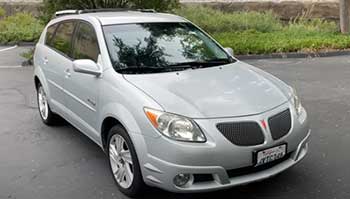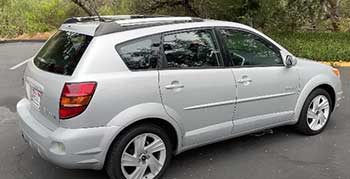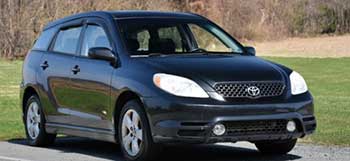
I’ve always been fascinated by cars that seem to share DNA yet wear different badges.
The Pontiac Vibe and Toyota Matrix are prime examples—compact hatchbacks born from a GM-Toyota partnership that feel like siblings with distinct personalities.
My goal is to walk you through my experience with both, breaking down their pros, cons, and key differences to help you decide which might suit your needs.
With a comparison table, maintenance tips, and an FAQ, I’ll share what makes these cars tick and why they’re still worth considering.
Comparison Table
| Feature | Pontiac Vibe | Toyota Matrix |
|---|---|---|
| Base Price (2003) | $16,485 | $14,670 |
| Engine Options | 1.8L (126-132 hp), 2.4L (158 hp) | 1.8L (126-132 hp), 2.4L (158 hp) |
| Fuel Economy (1.8L) | 26/31 mpg (city/highway) | 26/31 mpg (city/highway) |
| Interior Volume | 118 cu ft | 118 cu ft |
| Standard Safety Features | Stability control, OnStar, traction | Side airbags, ABS |
| Warranty | 5-yr/160,000 km powertrain | 5-yr/100,000 km powertrain |
| Resale Value | Lower due to Pontiac brand | Higher due to Toyota brand |
| Styling | Aggressive, Pontiac grille | Sleeker, more conservative |
My Experience With The Pontiac Vibe
Driving a Pontiac Vibe feels like slipping into a car that’s trying to be a bit of everything—part sedan, part wagon, part crossover. I first got behind the wheel of a 2005 Vibe during a road trip through the Rockies, drawn to its boxy charm and promise of Toyota reliability with a Pontiac badge.
The Vibe’s upright seating and high roofline gave me a commanding view of the road, almost like a mini-SUV. Its 1.8L engine, borrowed straight from Toyota’s Corolla, hummed along reliably, though it wasn’t winning any drag races. The interior, with its fold-flat seats and plastic cargo floor, screamed practicality, perfect for hauling camping gear or groceries.
What struck me most was the Vibe’s sporty edge. The Pontiac grille and angular headlights gave it a bolder look than its Matrix twin, and the available GT trim with its 180-hp engine added some pep. I remember zipping through mountain passes, appreciating the responsive steering, though the suspension felt a tad stiff on rough roads.
The Vibe’s interior wasn’t luxurious—think functional with a side of budget—but it got the job done. Features like the standard air conditioning and optional navigation system were nice touches for a car in this price range.
However, I noticed quirks. The cruise control, mounted on a stalk, was less intuitive than I’d hoped, and the HVAC system occasionally acted up, a common complaint among Vibe owners.
The Vibe’s assembly at the NUMMI plant in California meant it shared Toyota’s mechanical DNA, but some interior plastics felt cheaper than I expected. Still, the Vibe’s affordability—often priced lower than the Matrix—made it a compelling choice for budget-conscious buyers like me.
My Experience With The Toyota Matrix
The Toyota Matrix, on the other hand, felt like the Vibe’s more polished sibling. I drove a 2006 Matrix XR for a week, and its sleeker design caught my eye immediately. The rounded grille and smoother lines gave it a less aggressive vibe, appealing if you prefer understated style.
Inside, the cabin was nearly identical to the Vibe’s, with the same fold-flat seats and spacious cargo area. But the Matrix’s materials felt a touch more refined, and the dashboard layout was intuitive, with easy-to-read gauges.
Performance-wise, the Matrix matched the Vibe’s 1.8L engine output, delivering 126 hp in base models and up to 158 hp in the XRS trim. I found the Matrix’s ride smoother than the Vibe’s, especially on city streets, though it still wasn’t a sports car.
The optional all-wheel-drive system was a boon for wet Seattle roads, offering better traction than the front-wheel-drive Vibe I’d driven. The Matrix also boasted Toyota’s reputation for longevity, which gave me confidence during long commutes.
One downside? The Matrix’s front air dam scraped curbs more than I liked, a design flaw not as pronounced in the Vibe.
I also missed the Vibe’s standard OnStar system, which added a layer of safety the Matrix lacked unless you sprang for higher trims. But the Matrix’s higher resale value was hard to ignore—Toyota’s brand cachet clearly played a role here.
Pros Of The Pontiac Vibe

- Affordable Price Point: The Vibe often cost less than the Matrix, with a 2003 base model starting at $16,485 compared to $14,670 for the Matrix, but it included extras like a block heater and better tires.
- Spacious Interior: With 118 cubic feet of interior volume, it rivals larger cars like the Toyota Camry, making it ideal for small families or gear-heavy trips.
- Toyota Reliability: The Vibe uses Toyota’s 1.8L or 2.4L engines, known for longevity with proper maintenance, giving you peace of mind.
- Sporty Styling: The Pontiac grille and angular design give it a bolder look than the Matrix, appealing to those who want a touch of flair.
- Standard Safety Features: Stability control, traction control, and OnStar came standard, offering more safety than the Matrix’s base model.
- Versatile Cargo Space: The fold-flat seats and plastic cargo floor make it easy to haul everything from bikes to furniture, perfect for active lifestyles.
- Better Warranty: The 5-year/160,000 km powertrain warranty outshines the Matrix’s 5-year/100,000 km coverage, saving you on long-term repairs.
The Vibe’s blend of affordability and practicality made it a standout. I loved how it balanced Toyota’s dependable mechanics with Pontiac’s sporty aesthetic. The extra safety features and longer warranty gave me confidence, especially for a used car. Whether I was packing for a weekend getaway or navigating city streets, the Vibe felt like a reliable partner.
Read more: My Thoughts on GMC Terrain Vs. Ford Escape
Cons Of The Pontiac Vibe
- Cheaper Interior Plastics: Some interior components, like the wiring harness, felt less durable than the Matrix’s, possibly due to GM’s supplier choices.
- HVAC Issues: The air conditioning system can be finicky, with compressor or recirculation gear problems reported by owners.
- Lower Resale Value: The Pontiac brand’s decline means Vibes depreciate faster than Matrixes, impacting long-term value.
- Noisy Engine: The 1.8L engine gets loud at high RPMs, which can be annoying on long highway drives.
- Stiff Suspension: The ride can feel harsh on rough roads, especially compared to the Matrix’s smoother handling.
- Cruise Control Design: The stalk-mounted cruise control is less user-friendly than modern steering wheel setups.
- Limited Availability: Since production ended in 2010, finding a well-maintained Vibe can be a challenge compared to the Matrix.
The Vibe’s flaws weren’t dealbreakers, but they nagged at me. The noisy engine and stiff ride made long trips less pleasant, and the interior plastics sometimes felt like a step down from the Matrix. Resale value was a concern, too—if I wanted to sell later, I’d take a hit compared to a Toyota.
Pros Of The Toyota Matrix

- Higher Resale Value: Toyota’s brand reputation ensures the Matrix holds its value better, making it a smarter long-term investment.
- Refined Interior: The materials feel slightly higher quality than the Vibe’s, giving a more polished cabin experience.
- Smooth Ride: The suspension handles bumps better, offering a more comfortable drive, especially in urban settings.
- Reliable Mechanics: Like the Vibe, it uses Toyota’s bulletproof 1.8L or 2.4L engines, known for lasting with regular care.
- Sleek Design: The rounded grille and smoother lines appeal to those who prefer a less aggressive look.
- Optional AWD: The all-wheel-drive option boosts traction in adverse conditions, a plus for snowy or rainy climates.
- Modern Features: Later models offer Bluetooth and touchscreen infotainment, keeping it competitive with newer cars.
The Matrix felt like a refined version of the Vibe. Its smoother ride and better resale value were big wins for me, especially since I planned to keep the car for years. The understated styling and reliable mechanics made it a practical choice for daily driving.
Cons Of The Toyota Matrix
- Higher Initial Cost: The Matrix often carried a premium over the Vibe, with fewer standard features for the price.
- Front Air Dam Issues: The low front bumper scrapes easily on curbs or steep driveways, a design flaw that frustrated me.
- Fewer Standard Safety Features: Base models lack the Vibe’s stability control and OnStar, requiring upgrades for similar safety.
- Less Aggressive Styling: The conservative design may feel bland compared to the Vibe’s sporty look.
- Noisy at High Speeds: Like the Vibe, the 1.8L engine gets loud on highways, which can detract from comfort.
- Limited Leather Options: Unlike the Vibe, leather upholstery wasn’t available, limiting premium interior choices.
- Weaker Warranty: The 5-year/100,000 km powertrain warranty is shorter than the Vibe’s, potentially increasing repair costs.
The Matrix’s higher price and fewer standard features were noticeable drawbacks. The scraping front bumper was a constant annoyance in parking lots, and I wished for the Vibe’s bolder styling at times. Still, the Toyota badge carried weight.
Maintenance Tips For The Pontiac Vibe
- Regular Oil Changes: Use synthetic 5W-30 oil every 5,000 miles to keep the Toyota 1.8L or 2.4L engine running smoothly. These engines are durable but sensitive to neglected oil.
- Check Timing Chain: Both engines use a timing chain, not a belt, which lasts longer but should be inspected for stretching around 100,000 miles.
- Monitor Wheel Bearings: High-mileage Vibes often develop humming noises from worn bearings; replace them ($260-$370) if you hear this at highway speeds.
- Inspect Ignition Coils: Misfires (codes P0351-P0354, P0301-P0304) may signal a failed coil. Replace it and spark plugs simultaneously to avoid repeat issues.
- Flush Fluids: Replace brake fluid, coolant, and transmission fluid every 30,000-50,000 miles to prevent corrosion and ensure smooth operation.
- Check for Recalls: Verify NHTSA recalls, especially for 2005-2008 models with ECM issues or Takata airbags, to address safety concerns.
- Clean Plastic Cargo Floor: The cargo area’s plastic floor is durable but collects dirt; clean it regularly to maintain its utility.
Maintaining a Vibe is straightforward thanks to its Toyota roots. I found that sticking to a regular fluid change schedule kept my 2005 model running like a champ. Checking for recalls was a must, especially given the airbag issues. The plastic cargo floor was a lifesaver for messy loads but needed occasional scrubbing.
Maintenance Tips For The Toyota Matrix
- Frequent Oil Changes: Like the Vibe, use 5W-30 synthetic oil every 5,000 miles to protect the 1.8L or 2.4L engine from wear.
- Inspect Timing Chain: Check for chain stretching around 100,000 miles to avoid engine performance issues.
- Monitor Front Air Dam: Regularly inspect the low front bumper for cracks or damage from scraping; repair promptly to avoid costly fixes.
- Replace Wheel Bearings: Listen for humming at high speeds and budget $260-$370 for bearing replacements on high-mileage models.
- Check Electrical Components: Ensure the ECM is functioning, as 2005-2008 models may have recall-related issues causing stalling or harsh shifting.
- Update Fluids: Flush brake fluid, coolant, and ATF every 30,000-50,000 miles to maintain system integrity.
- Verify Airbag Recalls: Check NHTSA for Takata airbag recalls on 2003-2008 models to ensure passenger safety.
The Matrix’s maintenance needs mirror the Vibe’s, given their shared mechanics. I made a habit of checking the front bumper after every parking lot adventure to avoid bigger repairs. Fluid changes and recall checks kept my Matrix reliable, and the Toyota service network was a bonus.
Read more: My Thoughts on Acura Integra Vs. Honda Accord
Comparison With Other Brands
- Honda Fit: The Fit offers similar fuel economy (27/33 mpg) but less interior volume (90 cu ft) than the Vibe/Matrix’s 118 cu ft, making it less versatile for cargo.
- Ford Focus ZX5: The Focus has a sportier ride but poorer reliability ratings and less cargo space (93 cu ft) compared to the Vibe/Matrix.
- Mazda Protegé5: The Protegé5 matches the Vibe’s sporty vibe but has a less reliable engine and smaller cargo area (89 cu ft).
- Chrysler PT Cruiser: The PT Cruiser’s retro styling is fun, but its 22/29 mpg and less reliable mechanics lag behind the Vibe/Matrix’s efficiency.
- Subaru Outback: The Outback offers superior AWD but lower fuel economy (22/28 mpg) and a higher price point than the Vibe/Matrix.
- Nissan Versa Note: The Versa Note is cheaper but lacks the Vibe/Matrix’s interior space (94 cu ft) and Toyota reliability.
- Kia Soul: The Soul’s boxy design rivals the Vibe/Matrix’s cargo space but has a less refined ride and lower reliability scores.
The Vibe and Matrix stand out for their blend of space, efficiency, and reliability. I found the Honda Fit cramped for my camping gear, while the Focus felt less dependable. The Outback was tempting but pricier, making the Vibe/Matrix a sweet spot for value.
Frequently Asked Questions (FAQ)
They’re nearly identical, sharing Toyota’s Corolla platform, engines, and most components. Differences lie in exterior styling, interior materials, and branding.
Yes, they’re equally reliable due to shared Toyota mechanics, but the Matrix often has better resale value and slightly refined interiors.
Yes, all Vibes use Toyota’s 1.8L or 2.4L engines, ensuring consistent reliability across models.
Absolutely, thanks to Toyota’s engines and components. With regular maintenance, Vibes often exceed 200,000 miles with minimal issues.
Conclusion: For Pontiac Vibe And Toyota Matrix
You can’t go wrong with either the Pontiac Vibe or Toyota Matrix—they’re practically twins with Toyota’s reliable heart. I lean toward the Vibe for its lower price and sporty style, but the Matrix’s resale value and smoother ride might sway you.
Consider your budget, style preferences, and whether resale matters. Both offer practicality, efficiency, and durability, making them smart picks for budget-conscious drivers. Test-drive them, check their maintenance history, and you’ll find a versatile hatchback that fits your life.

